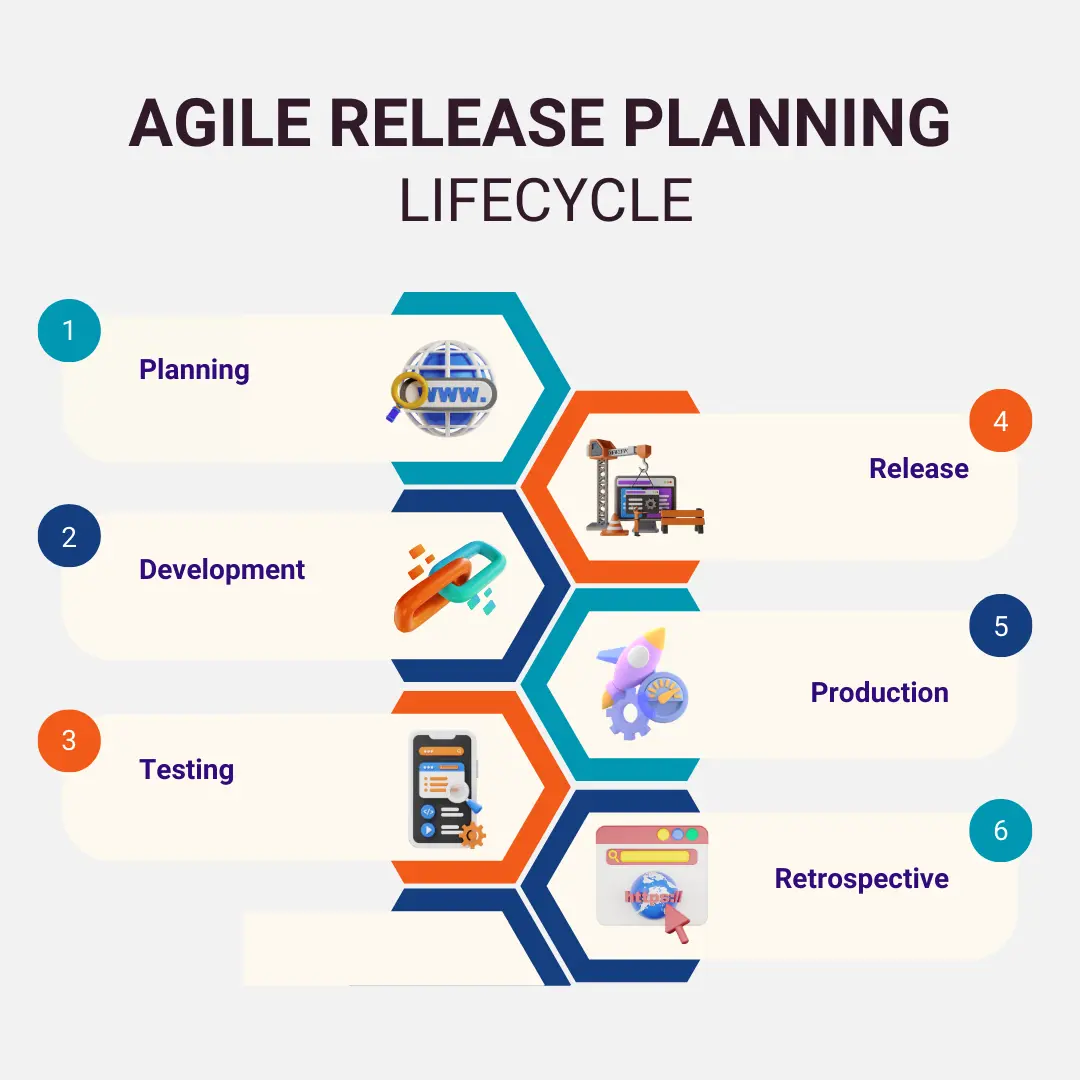In an ideal world, project plans would unfold smoothly from start to finish of execution. However, this is seldom the reality as lots of experienced product teams know.
Even the most experienced Product Owners struggle to perfectly predict the twists and turns associated with software development projects. This uncertainty leads to many late nights and stress when rigid deadlines loom.
That’s why Agile release planning has become popular for development teams. It’s an approach that breaks down product delivery into incremental stages rather than big-bang releases like with predictive methodologies.
In this guide, we’ll cover the basics of Agile release planning, how to implement it, as well the difference between Sprint Planning and release planning.
With the incorporation of Agile into the current PMP examination content, we’ll also provide tips for the PMP exam for any questions related to Agile release planning.
What is Agile Release Planning?
Agile release planning is an approach in Agile software development frameworks like Scrum where teams plan, build, and deploy products in incremental stages rather than in large, infrequent releases.
With Agile release planning, development cycles are broken into Sprints or iterations that conclude with a product increment.
The increment may not be released to users immediately but instead bundled together with other increments after multiple Sprints to form a major release which is planned for.
For example, your team might create internal product versions 1.1, 1.2, and 1.3 in three Sprints. After testing and getting feedback, you publicly release versions 1.1 and 1.2 as the 1.2 release.
The main purpose of Agile release planning is to provide continuous delivery of improvements to customers enabling you to incorporate feedback and adapt quickly through iterative development.
Release planning allows you to deploy smaller changes more frequently without overwhelming users, and gives structure and cadence to product updates aligned to an overall roadmap and vision.
While Agile release planning is especially applicable for web/SaaS products and mobile apps where continuous deployment is possible, the concepts can benefit hardware, marketing, and even internal IT projects too.

What is an Agile Release Plan?
An Agile release plan is a document that outlines how and when a team will deliver features or functionality for a product incrementally over multiple Sprints.
The release plan prioritizes user stories and requirements from the Product Backlog into upcoming releases based on business value and dependencies. It provides a roadmap for meeting larger product goals through continuous delivery.
The Agile release plan typically includes:
- Release goals and themes
- Scope of features/functionality to be included
- Timeline with target release dates
- Assumptions and risks
- Budget and resources needed
- Criteria for release approval
The plan is a flexible living document, updated based on feedback and learning that guides the team’s Sprint planning and development cadence.
Release plans give structure and visibility into the Agile development process without being prescriptive Gantt charts, enabling stakeholders to see progress towards the overall product vision through iterative delivery of value.

What is the Agile Release Life Cycle?
The Agile release life cycle outlines the process of building, testing, and deploying a release through multiple Sprint iterations:
- Planning: Product and release goals are defined. The backlog is prioritized and Sprint tasks are estimated.
- Development: The team works in Sprints to complete backlog items per the release plan. Code is written, reviewed, and unit tested.
- Testing: User testing and bug fixing occur during each Sprint, often involving test-driven development. Regression testing confirms new code doesn’t break existing features.
- Release: The product increment concludes the Sprint and is potentially released after testing, depending on the release plan.
- Production: Monitoring, customer support, and gathering feedback is crucial once a release is live. Feedback channels like analytics inform subsequent development.
- Retrospective: After a release or Sprint, teams conduct a retrospective to improve processes for the next iterations.
The Agile release lifecycle is a continuous, evolving loop. Lessons learned from the current release inform the next round of planning and development. Releases deliver incremental value repeatedly over the product lifecycle.
Purpose of Agile Release Planning
Agile release planning serves several key purposes:
1. Provide Continuous Delivery
Release planning enables continuous delivery of value to customers through regular incremental releases. Instead of major releases every 6-12 months, teams can deploy improvements weekly or monthly.
2. Incorporate Feedback
Frequent releases allow you to rapidly gather user feedback and respond with adaptations in upcoming Sprints. Release planning connects this learning cycle.
3. Communicate Release Cadence
The release plan gives stakeholders visibility into the development roadmap. They can see how releases align with the overall product vision through incremental delivery.
4. Guide Team Prioritization
Release goals help the team focus on the most high-value user stories during Sprint planning sessions. The plan guides their prioritization but remains flexible.
5. Measure Progress
Releases provide milestones to assess progress empirically. Teams can evaluate velocity and make data-driven decisions on scope based on previous Sprints.

How to do Agile Release Planning
Effective Agile release planning requires some upfront work as well as practice and collaboration between teams before constructing a timeline.
But following these key steps will help you build and deploy products that continuously deliver customer value.
1. Establish a Product Vision
Start by defining a clear, shared vision for what your product should achieve and who it ultimately serves.
The vision should align with your business strategy and market objectives, and be fully understood by all stakeholders to guide development priorities.
2. Build the Product Backlog
Next, capture all potential features, requirements, and user stories in a backlog. Then prioritize the backlog by value based on the vision, customer needs, and other inputs. This provides the raw material for release planning.
3. Map the Release Roadmap
With the prioritized backlog in hand, map a high-level release roadmap. Target major releases that bundle together related functionality and improvements. Make the roadmap flexible but use it to visualize an initial release cadence.
4. Estimate Team Velocity
Understand your team’s velocity – how much work they can complete per Sprint. This can be done by using past Sprints or industry benchmarks to estimate velocity as you plan capacity.
5. Hold Release Planning Session
Conduct a release planning session with stakeholders where you collaboratively review the vision, roadmap, and backlog priorities.
Define the goal and scope for the next release, then outline how many Sprints it may take to complete based on the team’s velocity.
6. Break Down Release into Sprints
Meeting with the development team, size and estimate backlog items for the release into individual Sprints. Make sure to incorporate time for testing and fixes. Use relative estimating techniques like planning poker.
7. Build the Release Plan Schedule
With Sprints defined, build out a release plan schedule for the cadence of Sprints from development to deployment. Share this living plan and review it regularly to inspect and adapt as you learn and gather feedback.
8. Refine and Repeat the Process
After each release, hold retrospectives to improve your process. Revisit the backlog to incorporate new learnings and reprioritize as needed. Then refine your next release plan following the same steps.
Agile Release Planning Best Practices
Here are some key best practices to consider when planning Agile releases to help your team continuously deliver and delight customers.:
Start with the Product Vision
Keep the overarching product vision at the core throughout planning. Use it to guide prioritization and confirm that the release goals support the vision. Revisit the vision before each release.
Review Previous Sprints
Look back at previous Sprints during release planning. Evaluate what went well and what can be improved. Check for unfinished stories rolling into the new release.
Estimate Collaboratively
Bring together different team perspectives when estimating and planning Sprints. Leverage collective knowledge of technical options, dependencies, and previous velocity.
Prioritize Ruthlessly
Resist the familiar urge to pack too many features into a release, even if the team tempts you with high velocity estimates. Prioritize ruthlessly and focus on what delivers the most customer value.
Plan Testing In Early
Build time for usability testing and bug fixing into release plans upfront. Don’t leave it as an afterthought or you risk quality issues. Validate releases before deployment.
Update Plans Regularly
It’s inevitable that release plans will change. So, review them often based on new learnings and feedback, and make small course corrections early to keep on track.
Automate When Possible
Automated testing and continuous delivery approaches like CI/CD streamline release planning. Leverage automation to deploy and gather feedback faster.
Communicate Progress
Keep stakeholders informed on release progress through demos and status updates. Also, celebrate release milestones together as a team.

Difference Between Sprint Planning and Release Planning
Sprint planning and release planning are distinct but related activities in Agile development. So, what’s actually the difference between them?
1. Timeframe
Sprints represent short 1-4 week cycles to complete a product increment. Release planning has a longer multi-sprint timeline focused on deploying a set of increments.
2. Scope
Sprint planning details the specific stories and tasks for a single increment. Release planning on the other hand defines goals and prioritizes features that may span multiple Sprints.
3. Level of Detail
In Sprint planning, the developers estimate and assign granular stories or tasks. In contrast, release planning works from a higher level of product requirements and goals.
4. Attendees
The development team owns Sprint planning. Release planning involves Product Owners and key stakeholders to align on strategy.
5. Flexibility
Sprints are meant to be consistent cycles. Release plans are open to change based on feedback and learning.
6. Outcomes
A Sprint produces a tested product increment for potential release. Release planning delivers this value incrementally over multiple Sprints.

Agile Release Planning PMP Exam Tips
With a solid grasp of how Agile release planning bridges product strategy to team execution, you’ll ace any questions on this topic in the PMP certification exam.
Here are some key tips for the PMP exam on Agile release planning:
- Know the purpose of Agile release planning is to continuously deliver value through incremental releases aligned to an overall product vision.
- Understand how Agile release planning gives guidance and cadence to multiple Sprint cycles that conclude with potentially releasable increments.
- Be able to describe the process of grooming the backlog, estimating velocity, planning Sprints, and constructing a release timeline.
- Recognize that Agile release planning happens at a higher level than Sprint planning, with more involvement from product owners and stakeholders.
- Remember that Agile release plans are flexible guides that teams inspect and adapt based on feedback and evolve over time, unlike rigid Gantt charts.
- Expect questions on balancing business value priorities versus team execution capacity during planning.
- Be prepared to compare and contrast release planning with roadmaps, Sprints, and basic Agile principles.
- Know common release planning best practices like starting with clear goals, limiting scope, updating stakeholders, automating deployments, and holding retrospectives.
- Brush up on estimating techniques like story points and planning poker that feed into release planning.
- Review the various Agile frameworks like Scrum and Kanban that leverage Agile release planning.
Conclusion
Agile release planning is a process for software teams to deliver continuous value. By taking an incremental, iterative approach to product development and deployment, teams can adapt quickly based on user feedback.
Effective Agile release planning starts with a clear product vision and roadmap. Teams then work in short Sprints to build, test, and potentially release releasable increments that move towards the larger goals.
With the right vision, practices, and tools in place, you can plan iteratively and delight customers with frequent product improvements.
FAQs
Who is Responsible for Release Planning in Scrum?
In Scrum, the Product Owner is responsible for release planning, with input from the development team to assess technical feasibility and effort. They prioritize backlog items to meet release goals and deliver value.
When is Release Planning Done?
Release planning is typically done at the start of the product development cycle and revisited at the beginning of each Sprint during the Sprint Planning Meeting, ensuring continuous alignment with project goals, stakeholder expectations, and team capacity.
How Many Sprints Are in a Release?
The number of Sprints in a release varies based on project scope, Sprint length, and release goals. It’s determined by the Product Owner with the development team’s input, balancing feature delivery with market needs and technical constraints. There’s no fixed number; it’s flexible and adaptive to the project’s context.





